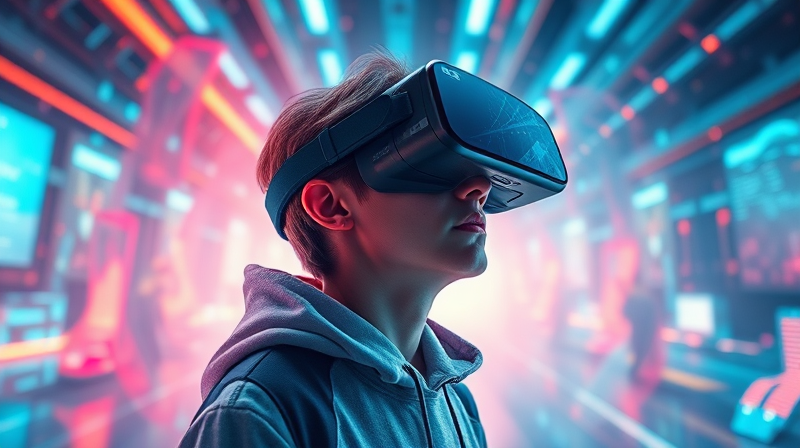Virtual reality has transformed the way we experience digital content by opening up new dimensions of interaction and immersion. As we approach 2025, understanding the basic principles of VR is key to fully appreciating the innovations taking place in this field. This article is designed to help beginners understand the essentials of VR and to inspire them to explore its endless possibilities.
Embracing a New Digital Frontier: Virtual reality is not just a technological trend; it is a new frontier that merges creativity, technology, and human interaction. With a blend of hardware and software advancements, VR has evolved into an inclusive ecosystem that caters to educational, entertainment, and business needs alike.
Understanding the Basics of VR
The foundation of virtual reality lies in its ability to create a simulated 3D environment that captivates the senses. By using a headset that offers dual-screens for each eye, VR systems can produce a stereoscopic 3D effect, giving the user a true sense of depth and spatial awareness. This realism is enhanced by motion controllers that serve as the bridge between the physical and virtual world.
Simulated Immersion: The core objective of VR is to seamlessly blend the real with the virtual, allowing users to experience computer-generated environments as if they were physically present. This evolution in digital interaction paves the way for more intuitive and interactive experiences.
Types of VR Headsets
There are several kinds of headsets available today, each designed to meet specific needs and budgets:
- Standalone Headsets: Devices such as the Meta Quest 3 operate without any external hardware. They showcase built-in processing power, making them ideal for users who seek simplicity and mobility.
- Tethered Headsets: Brands like HTC Vive and Valve Index deliver exceptional graphical performance by connecting to powerful gaming PCs and are perfect for immersive gaming and detailed simulations.
- Mobile VR: For budget-conscious users, mobile VR headsets represent an accessible entry point, leveraging smartphones to deliver a variety of interactive experiences.
Choosing the right headset involves evaluating your personal needs, budget, and the types of experiences you wish to engage in. Whether you’re looking for gaming thrills or educational journeys, there's a device designed to provide you with an unparalleled VR adventure.
Setting Up Your VR Environment
A well-organized and safe space is critical for an enjoyable virtual reality experience. Begin by selecting a headset that matches your preferences and ensuring you have a clear and open area free of obstacles.
Tips for a Comfortable VR Setup:
- Designate a room or area specifically for VR activities.
- Remove or rearrange furniture to create a spacious environment.
- Check the headset fit and adjust it for extended usage without discomfort.
Taking these simple steps will minimize the risks of collisions and injuries, ensuring that your exploration into VR is both secure and enjoyable.
Exploring VR Content and Trends
Once your VR system is up and running, the next exciting step is to explore the many dynamic experiences available. Platforms like the Oculus Store and Steam VR host an extensive library of VR content, ranging from immersive gaming worlds to educational simulations that transport you to different times and places.
Key VR Trends Shaping the Future:
- Immersive educational experiences are revolutionizing traditional learning methods by creating virtual classrooms that enable experiential learning.
- Hyper-realistic simulations are breaking down the boundaries between physical and virtual realities, making interactions feel almost tangible.
- Social VR platforms are fostering new forms of interaction where users can communicate and collaborate in real time within virtual spaces.
- Artificial intelligence is being integrated to enhance personalization and create more intuitive user interfaces.
- The corporate world is increasingly adopting VR for training, design, and even customer engagement, showcasing its versatility beyond entertainment.
These trends exemplify the rapid evolution of VR and hint at a future where its applications in education, business, and entertainment continue to expand exponentially.
Overcoming Common VR Challenges
Despite its exciting potential, beginners must be aware of challenges like motion sickness, eye strain, and the learning curve associated with new technology. Each of these issues can be mitigated with proper techniques and minor adjustments.
Strategies to Tackle VR Discomfort:
- Start with shorter sessions and gradually build up your tolerance to VR experiences.
- Take regular breaks to relieve eye fatigue and remain aware of your physical surroundings.
- Customize settings and tweak the device adjustments to reduce instances of motion sickness.
Understanding these challenges and their solutions helps create a more positive and sustainable VR usage experience.
Looking Ahead: The Future of VR
The landscape of virtual reality is on an upward trajectory, bolstered by innovations such as the Apple Vision Pro, which reimagined user engagement with high-resolution displays and ergonomic designs. As VR becomes increasingly integrated into daily life, its influence will likely extend to even more aspects of work and recreation.
VR has immense potential to change how we learn, work, and socialize. Whether it’s exploring historical events through interactive timelines or engaging in real-time collaborative projects with colleagues, the journey into virtual reality is laden with opportunities for growth and discovery.
Embrace the Adventure: With the fundamentals of VR firmly in hand, you are well-equipped to embark on a journey filled with innovative experiences and endless possibilities. Stay curious, explore widely, and remain open to new technological breakthroughs that can further enhance your digital escapades.
For anyone new to the world of VR, these initial lessons serve as a roadmap to navigating this exciting domain. As you continue to explore and immerse yourself in virtual worlds, remember that every step taken is a stride towards a more connected and technologically advanced future.







